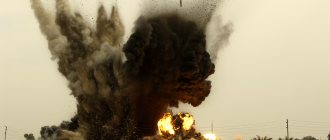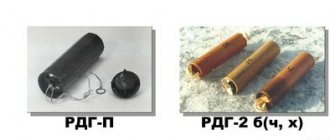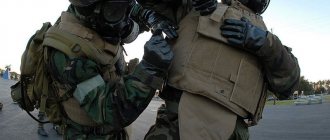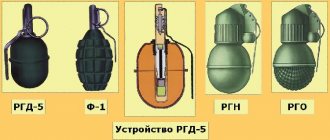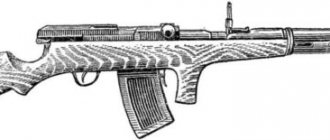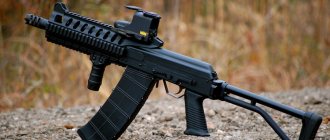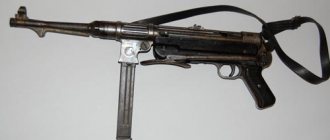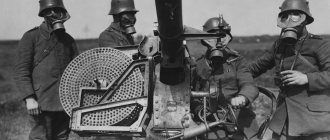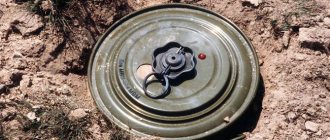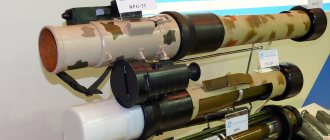Explosive means (SV). Part I
High explosives usually have unsatisfactory sensitivity to external influences (impact, fire, spark, friction, chemical influences). On the one hand, the low sensitivity (or even better, the complete lack of sensitivity to all types of external influences except detonation) of high explosives is a positive quality, which ensures the safety of their use. On the other hand, explosives are designed to explode and require means to put the explosive into action. These means are called explosive means - SV
.
All high explosives are very sensitive to one type of external influence - detonation, i.e. explosion of another explosive in contact with the first. There is a group of explosives called "Initiating explosives". These explosives are very sensitive to impact, fire, sparks, and chemical reactions. In order to initiate an explosion of a high explosive, the explosion of the initiating explosive is first excited by external influence. In order to make the use of initiating explosives possible and sufficiently safe, a certain amount of such explosives is placed in various packages (capsule, detonator cap, primer sleeve, electric detonator, fuse, etc.). These packages are usually designed so that external forces can be applied to them. For example, an electric detonator is a metal tube filled with an initiating explosive; wires with a spiral are also inserted there. The spiral is surrounded by an incendiary composition. When voltage is applied to the wires, the coil becomes hot and the incendiary composition ignites. When exposed to open fire, the initiating explosive explodes. If the electric detonator at this moment is located in the thickness of the high explosive, then the explosion of the electric detonator will cause an explosion of the main charge. That's what was required.
In addition to the packages themselves with the initiating explosive, the concept of “explosive means” also includes devices that provide external influences on these packages (fuse mechanisms, fire cord, strikers, etc.). For example, to initiate an explosion of gunpowder in a cartridge case, the cartridge is equipped with a primer. And the bolt striker acts on the capsule. From the point of view of sappers, the SV here consists of a primer and a weapon bolt.
SV for fire blasting method
There are various ways to explode high explosives. The simplest and most accessible is the fire method of explosion. Its essence is that a so-called detonator capsule is placed in a charge (a certain, calculated amount) of an explosive, into which a fire cord is in turn inserted. The bomber sets fire to the fire cord. After some time, the force of fire will reach the detonator cap and cause an explosion of the initiating explosive located in it. The explosion of the detonator cap will cause the main explosive charge to explode.
Detonator capsule No. 8.
The Russian army uses two of its modifications - KD No. 8-A and KD No. 8-M. The difference between them is the body material (aluminum or copper) and the type of initiating explosive used. The fact is that these explosives are chemically aggressive. One of them does not react with copper, and the other with aluminum. The dimensions of both detonator capsules are the same - length 45-51 mm, diameter 7 mm. On one side the CDs are open and the end of the fire cord is inserted there. In the figure (from top to bottom): KD No. 8-A, KD No. 8-M, KD No. 8-M (training inert), KD 8-A (imitation).
Fuse
designed to transfer the flame force to the pressure chamber from the blaster after a strictly defined period of time. The time interval from the moment of ignition of the end of the cord to the moment of explosion depends on the length of the cord. Standard Russian fire cords have a stabilized burning rate of 0.33 or 1 cm per second. Main brands of fire cord:
- OSHP.
The shell is plastic, grayish-white. Cord diameter 5-6 mm. burning speed in air is 0.86 - 1 cm per second. When burning in water deeper than 5 m, the burning rate increases slightly. A burning cord under water does not go out, provided that the other end is closed hermetically. The OSH with a blue shell burns at a speed of 0.3 -0.34 cm per second. - OSHA.
Shell made of cotton asphalted threads. The shell color is dirty gray with black spots. Characteristics similar to OSHP, but not recommended for blasting in water. - OSHDA.
The cord is similar to OSHA, but has a double sheath and can be used for blasting in water.
All fire cords are produced and supplied to the troops in 10-meter coils. The required amount of cord is cut from the coil.
A piece of fire cord connected to a detonator cap is called a " fire tube"
". To produce an explosion, the incendiary tube is inserted with a detonator cap into a specially prepared explosive charge socket, the open end is ignited and after a specified period of time an explosion occurs. In all cases, the minimum length of the fire cord in the ignition tube cannot be less than 50 cm (50-55 seconds of burning). When working to protect bridges from ice drift, specially trained demolition workers can use incendiary tubes with a cord 10 cm long.
The industry produces standard incendiary tubes that have mechanical or grating ignition devices at the end, which facilitates the use of the fire method of explosion by insufficiently trained personnel (there is no need to make an incendiary tube, no skills are required in igniting the ignition tube with matches). In the picture above, a factory incendiary tube with mechanical igniter, with a grating igniter at the bottom. To ignite the ignition tube, it is enough to pull the pin on the mechanical igniter. and unscrew the head of the grater and pull it sharply
The following brands of standard igniter tubes are available:
- ZTP-50.
The igniter is mechanical or grating. Burning time 50 sec. (underwater 40 sec.). The cord color is white. - ZTP-150.
The igniter is mechanical or grating. Burning time 150 sec. (underwater 100 sec.). The cord color is white. - ZTP-300.
The igniter is mechanical or grating. Burning time 360 sec. (underwater 300 sec.). Cord color is blue.
If with the electric method of explosion the simultaneous detonation of several explosive charges does not cause difficulties due to the simultaneous supply of an electric pulse from the blasting machine to several electric detonators, then with the fire method of explosion it is impossible to achieve the simultaneous ignition of several incendiary tubes, and the difference in length will lead to non-simultaneous detonation of the charges. With the fire method of detonation, the problem of simultaneous detonation of several charges distant from each other is solved by transferring detonation from charge to charge using a detonating cord. Considering that the detonation transmission speed is more than 6 km. per second, the detonation of any number of explosive charges and at any distance from each other can be considered simultaneous.
Detonating cord
designed to transfer detonation from one charge to another for the purpose of simultaneous detonation of several explosive charges distant from each other
The following brands of detonating cord are produced by industry:
- DS-A.
The shell is white cotton with red thread. Outer diameter 5-6 mm. PETN core. Detonation transmission speed 6500 m per second. Temperature range of application from -28 to +50 degrees. Water resistance 10 hours. - DSH-B.
The shell is cotton red. Outer diameter 5-6 mm. PETN core. Detonation transmission speed 6500 m per second. Temperature range of application from -28 to +50 degrees. Water resistance 10 hours. - DSH-V.
The shell is red plastic. Outer diameter 5-6 mm. PETN core. Detonation transmission speed 6500 m per second. Temperature range of use from -35 to +55 degrees. Water resistance 24 hours.
Detonating cord of all brands is produced in coils of 50 m. For use, the necessary sections are cut from the coil. A detonator cap No. 8 is attached to the end of the DS segment, which is then inserted into the explosive charge. The second end of the DS is connected to the main detonating cord, or sections of the DS from several charges are connected to the incendiary tube. When the incendiary tube is detonated, the detonation is transmitted through the blast furnace to the explosive charges. The figure shows several options for connecting several charges with a detonating cord for their simultaneous detonation with one incendiary tube. The distances between charges can be arbitrarily large
In addition to the above-mentioned SVs, a smoldering wick (TF), which is a cotton cord with a diameter of 6-8 mm, is also used for the fire explosion method. impregnated with saltpeter. It is colored yellow and, when ignited, smolders at a speed of about 1 cm per 1-3 minutes. It is used to ignite the incendiary tube when a long time is required from the moment of ignition to the explosion, and it is impractical to use the igniter cord. The TF is connected to the open end of the incendiary tube, which has a short section of OSH. Demolitionists use TF as part of incendiary tubes reluctantly due to the inability to calculate its burning time, and more often it is used to ignite a large number of incendiary tubes in order to save matches. In addition, when using the fire method of explosion, “Sapper Matches” are used. They are widely known among hunters and fishermen under the name "Hunter's Matches". They are convenient because they light up and burn steadily in any wind.
In the fire blasting method, in addition to the explosives, an auxiliary tool is used, which is included in the set of the mine-demolitionist's bag (MSP). This is, first of all, a crimper (a tool that looks like ordinary pliers, but with a calibrated hole in the jaws. Only with its help can you crimp the detonator cap when attaching a fire cord to it), a sapper knife, pins, high-strength thread, various checks, cases for carrying capsules -detonators, etc.
From the author.
The very sensitive initiating explosive is separated from the explosive only by a thin shell of the detonator capsule. A CD explosion occurs when it falls from a table to the floor, is squeezed by fingers, or is bent by the body. When a CD explodes in the hands, the result is standard - three fingers are torn off and an eye is knocked out (sometimes the left one, sometimes the right one, but always one). Handling CD requires preliminary training and the acquisition of certain skills. CDs can only be carried in special cases. Even inept removal of the CD from the factory closure can cause an explosion. Well, reckless drivers who carry CDs in their trouser pockets pay with a breakaway... However, this is fair. So that the idiots don't breed.
From the author.
For some reason, among people who are not experts in demolition, the fire cord is persistently called “bickford cord.” This outdated and completely incorrect name is common even in the army. However, calling a cord that way is as legitimate as calling a MIG-29 fighter an airplane. The design of fire cord and fire cord is very different.
From the author.
Lighting a lighter pipe with matches is not that easy. If a trained demolitionist spends one match on one pipe, then an inexperienced one will spend 10-15 without any guarantee that he will still cope with this task.
From the author.
Despite the apparent simplicity of using the DS, its use requires certain knowledge and skills. This applies, first of all, to techniques and methods of connecting cord sections. You need to know the types of knots allowed for tying DS and be able to knit them. Otherwise, instead of transmitting detonation, the cord will simply be interrupted at the connection point, and the task will remain unfulfilled. A knowledgeable demolitionist will be able to detonate an explosive charge using a blast gun, even without using detonator caps.
(Beginning. Continuation and Ending in the articles “Means of Explosion (SV). Part II
,
Part III
and
Part IV
")
Veremeev Yu.G.
Methods and means of detonating charges during mining operations
Industrial (working) explosives, their classification and marking Read more: Calculation of the explosive chain
4. Methods and means of detonating charges during mining operations
4.1. The principle of the design of combat charges
All explosives, without exception, have enormous efficiency and in this regard are very useful for humans, but, unfortunately, their power is used for the most part to his detriment. The entire history of mankind is a search for the most effective means of self-destruction, and in this it has achieved noticeable success.
All explosives have the common disadvantage that their use requires special precautions, especially those with high sensitivity. Fortunately, it is not the same for different explosives, and the technology for their differentiated use, both in combat and industrial applications, is based on this.
The technology for using explosives everywhere has a general principle. According to their purpose in explosive devices, explosives are divided into two types: working and initiating. The main task of the former is to perform useful work, and of the latter – to initiate (force) phlegmatic (low-sensitive), but highly efficient explosives to explode. The need to use such a charge device is related to safety precautions. Initiation does not require a large mass of a sensitive explosive, and a large mass of a working explosive, due to its low sensitivity, does not in itself pose a particular danger. Moreover, in order to reduce the risk to a minimum, an explosive chain is used with two initiating explosives: primary, which, having the greatest sensitivity and the smallest mass (mercury fulminate, lead azide), explode first and secondary (ten, hexagen, tetryl), which, receiving the impulse from the former is transferred to the charge of the working explosive (gunpowder, ammonites, dynamites, TNT, etc.). This entire chain, connected in series, represents a live cartridge, and the part of it with initiating substances is called a detonator capsule. In mining, explosive cartridges are manufactured directly at the explosion site; detonator caps and working explosives are stored separately.
4.2. Methods for detonating warheads
Detonation of warheads is associated with considerable risk, so much attention is paid to the technology of this part of the explosive and explosive system. There are three main ways to detonate charges: fire, electric, and detonation. The choice of one or another of them is determined, on the one hand, by the availability of explosive means, and on the other, by the conditions and safety requirements.
The fire method is the easiest to implement and the cheapest. The disadvantages are the relative danger (the location of the blaster directly at the site of the explosion), the impossibility of checking the quality of explosion preparation, and the difficulty of exploding groups of charges. Premature destruction of one charge by another cannot be ruled out. According to safety requirements, the fire method cannot be used in vertical and steeply inclined mine workings and in any workings hazardous for gas, dust, and oil products.
The electric method has no restrictions, the safest, the number of charges being detonated is not limited. But it is more complex and expensive, requiring the use of special equipment and calculation of the resistance and current of the circuit.
The detonating method is not widely used in mining operations, but it can be used in principle in any conditions (for workings hazardous for gas and dust, special safety detonating cords are used).
4.3. Explosive means
Explosive means include:
1/ in case of fire explosion - a fire cord, means of igniting it and detonator caps;
2/ for electric - electrically conductive cord, current sources and electric detonator capsules.
3/ for detonating - detonating cord and means of its initiation (capsule or electric detonator).
Fire cord and ignition means.
The fire cord is a core of black powder with a central guide thread and braids coated or impregnated with a moisture-proof or waterproof mass (Fig. 18). For underwater blasting, the cord is produced in gutta-percha or vinyl chloride insulation.
According to the burning speed, the fire cord is divided into: normally burning with a burning speed of 1 cm/sec, the color of the braid is gray, and slow-burning - with a burning speed of 0.5 cm/sec (the distinctive color of the braid is yellow). The fire cord is used to transfer a sheaf of sparks to the initiating explosive located in the detonator capsule.
The fire cord is ignited using a smoldering incendiary wick or candle. For simultaneous group ignition of a large number of sections of fire cord, incendiary cartridges are used. Such cartridges, designed to simultaneously ignite up to 30-37 pieces of cord, can be ignited either using a short piece of cord or using an electric igniter.
Detonating cord.
The detonating cord is designed to transmit detonation to industrial explosive charges.
All industrial explosives explode reliably enough from a detonating cord and, in this case, do not require the use of detonator caps in blast holes. The cord itself detonates from the explosion of the detonator cap or electric detonator. It detonates at high speed (about 7000 m/sec), which ensures the simultaneous explosion of a large number of explosive charges.
The detonating cord consists of several braids, coated with mastic or plastic compound, and a core of highly explosive explosive / heating element. RDX / with two red guide threads or red insulation. A regular detonating cord/DSHA, like a fire-conducting cord, is prohibited from being used in workings that are hazardous due to gas or dust. For these conditions, it is allowed to use only safety waterproof detonating cords of the DShP-1 and DShP-2 brands.
The detonating cord is relatively safe, it can be cut into pieces with a sharp knife, it ignites with great difficulty and burns quietly without flashes. However, it is not allowed to ignite sections longer than 10-12 cm, since combustion can lead to an explosion. Cutting the cord is only allowed on a wooden board at a distance of at least 10 m from explosives.
Detonator caps and electric detonators.
In principle, an electric detonator differs from a conventional detonator only in the presence of an electric igniter and, in the case of a delayed-action electric detonator, in the presence of a retarding composition. Their purpose is the same.
Detonator cap. The detonator cap used to detonate the main explosive charge is a charge of primary and secondary initiating explosives pressed into a copper, brass, aluminum or paper sleeve (Fig. 20).
Mercury fulminate or lead azide are used as the primary initiator. In the first case, the case material must be paper, copper or brass (the detonator brand has the letters B or M). In the second case - paper or aluminum (in the detonator brand the letters B or A). To make the explosion of azide detonators more reliable, their primary initiator charge is coated with a small addition of teneres.
Tetryl, ten, and hexagen are used as a secondary initiator placed in the lower part of the sleeve. A cumulative recess is produced in the end part of the secondary initiator. The upper part of the sleeve remains empty for inserting the end of a piece of fire cord there.
Detonator capsules must be protected from moisture; in addition, they must not be dropped or subjected to even light impacts or heat. Under the influence of direct sunlight, they sharply increase their sensitivity to external influences. In mines that are hazardous due to gas or dust, caps - Detonators, as well as fire explosion, are unacceptable.
They are produced only for instant action. The required sequence of explosion of explosive blast charges is achieved either by pieces of cord of different lengths, or by a certain sequence of ignition.
Detonator capsules are produced only in flammable tetril No. 8 and azidotetril No. 8.
An electric detonator is a device that converts electrical energy into thermal energy, causing a flash of a flammable composition that initiates an explosion of the working explosive (Fig. 21).
The incandescent bridge, represented by a 30-50 m constantan or nichrome wire, is surrounded by a flammable compound in the form of a solid drop. As such a composition, a mixture of 46% berthollet salt, 28% thiocyanate lead and 26% wood glue is used. The ends of the bridge are brought out through detonator conductors with a diameter of 0.5 mm and a length of 1.5 to 2.5 m. The electric igniter in the detonator barrel is secured with moisture-proof mastic or a plastic plug.
Electric detonators require careful handling; pulling the conductors or creating any other mechanical load on them is prohibited. They are instantaneous (ED), delayed (ED-ZD) and short-delayed (ED-SC).
Delayed-action electric detonators between the electric igniter and the primary initiator have a remote tube with a moderator (a mixture of barium peroxide, potassium nitrate and iditol). The deceleration time, which varies from 0.5 sec to 10 sec for various electric detonators, depends on the length of the remote tube.
Instant-action electric detonators are allowed to be used in any work; delayed-action electric detonators are also allowed, except in workings hazardous due to gas or dust, where their use is strictly prohibited.
Short-delay electric detonators between the electric igniter and the primary initiator contain a moderator consisting of a mixture of red lead, silicocalcium and ferrosilicon. The magnitude of the deceleration time, which for various electric detonators ranges from 25 to 250 ms (with intervals from 25 to 100 ms), depends on the length of the retarding composition.
Short-delay electric detonators can be used for any type of blasting work, incl. and in workings hazardous for gas and dust. When using short-delayed detonators, the hole utilization rate increases; In addition, there is a finer and more uniform crushing of the rock, a more uniform (heaped) rock rejection, the seismicity of the explosion and the consumption of explosives are reduced.
In mines hazardous for gas or dust (with the exception of seams subject to sudden outbursts), short-delay electric detonators, using the ED-8-56 electric detonator as a zero deceleration, can be used provided that the total deceleration period does not exceed:
A) in coal faces - 120 ms, blasting in one step;
B) in mixed rock faces - 120 ms, blasting in no more than two stages;
C) in pure rock faces - 170 ms, the number of blasting techniques is not limited.
Conductors of electric current.
To transmit electric current from a current source to detonators, insulated copper and, less commonly, aluminum conductors are used.
Depending on the purpose, the conductors are wound as detonator, connecting and main ones. The cross-section of the detonator conductors is 0.20 mm2, diameter - 0.5 mm. Wires with a cross section of 0.75+1.50 mm2 and a diameter of 1.0-1.5 mm are used as connecting and main conductors. The use of conductors with cotton insulation is allowed only in dry places; in damp or wet workings, conductors only with impermeable rubber and vinyl insulation are used.
The system of all conductors and electric detonators connected to each other in a certain sequence is called an electroexplosive network.
Current sources and instrumentation.
Dry cell batteries and accumulators, power and lighting lines of constant alternating electric current, and blasting machines can be used as current sources in the mining industry.
In the practice of sinking mining and exploration workings, explosive machines should be given preference, as they are easy to use and reliable in operation. At the site of production and blasting operations, there may be no industrial electric current, and then the role of the machine increases even more. There are two main types of blasting machines: dynamo-electric and capacitor.
Dynamo-electric machines consist of a portable direct current electric generator, a drive mechanism with a handle or key, a contact device and clamps; for connecting the main wires of the explosive network to the machine. An example of such machines would be the PM-1, PM-2 and VM-10 machines. All of them can be approved for any work, except workings hazardous for gas or five.
However, capacitor machines have become more widespread, as they are more powerful and lighter in weight. They work on the principle of accumulating charge on a capacitor and instantaneously discharging it. According to the principle of power supply (charging), capacitors are divided into inductor, rechargeable and battery. Machines of this type are available in both standard and explosion-proof versions. The latter can be used in any work, including workings hazardous due to gas or dust.
Of the capacitor machines, the most widely used machine is the VMK-3/50. This machine is produced in an explosion-proof design, and its power is quite sufficient for blasting operations in any exploration workings. One of the necessary conditions for the failure-free operation of an explosion is the following: the actual resistance value of the explosive network should not exceed the limit value specified in the characteristics of the explosive machine. During electric explosions, electrical measuring instruments are used to test electric detonators, select them based on resistance, to check the integrity of the explosive network and determine its resistance. The main ones are: linear explosive bridge LSh-48, small ohmmeter and explosive tester VIO-3.
Industrial (working) explosives, their classification and marking Read more: Calculation of the explosive chain
Information about the work “Mining excavations”
Section: Geology Number of characters with spaces: 151351 Number of tables: 0 Number of images: 0
Similar works
Mining and geological characteristics of the mine
154848
6
60
... can be applied throughout the entire deposit, since the design of the system allows mining of the ore body in any mining and geological conditions 5. Occupational health and industrial safety 5.1 General provisions All mining and construction work at the Taimyrsky mine is carried out in accordance with the requirements " EPB in the development of ore, non-metallic and alluvial mineral deposits...
Development of shaft sinking at the Kostenko mine
104602
8
0
... up to the mark - 50 m are classified as fatty medium metamorphic, deeper - classified as fatty high metamorphic, coals of the K18 seam are mainly fatty low metamorphic, and in small quantities - fatty medium metamorphic. At the Kostenko mine, K10 seams are currently being developed. Seam K10: dip angle 7-9 degrees, total thickness of the seam 4.5 meters, complex structure - 9-10 coal packs...
Driving the cross-cut 490 m
26675
14
0
... be at least 100 mm, and for district police officers - at least 50 mm. Main lines are laid in vertical and inclined shafts, adits, near shaft yards, main and group haulage drifts, cross-cuts and slopes. The ends of local fire-irrigation pipelines must be no more than 50 m from the faces of the development workings and be equipped with a fire hydrant, which ...
Rock fracturing, its influence on changes in the physical and mechanical properties of rocks using the example of the Noyon-Tologoy deposit
39305
2
8
... up to 15-40 meters. Hydrothermal changes are represented by propylitization, argillization, silicification, carbonatization, chloritization, and sulfidization. 3. The influence of fracturing on changes in the physical and mechanical properties of rocks. The determining factor in the variability of the physical and mechanical properties of rocks is structural and tectonic conditions, which in turn determine the development of secondary...
Main menu
Share the news with your friends
The products described below are mainly intended for the manufacture of charges of the required mass and shape. They are rarely used as independent demolition charges.
TNT block weighing 75 grams
Designed primarily for blasting in soils, in particular for use in holes formed by drilling tools. Hence the common name “drill block”. It is also usually used in practical classes when teaching blasting.
It has a cylindrical shape.
Diameter 30 mm. Length 70 mm. The explosive is compressed TNT.
At the end of the checker there is a ignition socket for a detonator cap No. 8 (diameter 7.2 mm, depth 56 mm). It may have an M10x1 thread with a depth of 5-8 mm in the upper part of the ignition socket. In this case, individual batches of checkers may have a thread lining made of foil.
The checker is wrapped in waxed paper of red, gray, yellow, gray-blue or green. A black spot with a diameter of 5-6 mm is applied to the end above the ignition socket.
From the author. In my life I have never seen TNT blocks with a threaded ignition socket, although I have blown up quite a few during my service. I haven't seen any.
Marking. On the side wall there is an inscription in black letters along the long side “TNT block weight 75g.” Other inscriptions are possible.
For example, “TNT block 75g”, “TNT sulfide 75 g”, “75-gr. TNT block", "TNT block 75 gr. with thread m10x1".
Capping
Checkers 250 pcs. packed in a green wooden box measuring 49x35x25 cm. Gross weight 26 kg. Weight of explosives in a box is 18.75 kg. The use of a box with checkers as a demolition charge is not intended.
The picture on the right shows a cross-section of a 75 gram block with a threaded igniter socket with a foil lining.
TNT block weighing 200 grams
Designed primarily for making explosive charges of various masses.
It is a parallelepiped. Length 100 mm, width 50 mm, thickness 25 mm.
The explosive is compressed TNT.
At the end of the checker there is a ignition socket for a detonator cap No. 8 (diameter 7.2 mm, depth 56 mm). There is no thread in the ignition socket.
The checker is wrapped in waxed paper of red, gray, yellow, gray-blue or green.
A black spot with a diameter of 5-6 mm is applied to the end above the ignition socket.
Marking
On the wide side wall there is an inscription in black letters running along the long side “TNT block weight 200g.” Other inscriptions are possible. For example, TNT block 200g”, “TNT sulfide 200g”, “200g. TNT block"...
Capping
Option 1. Checkers 123 pcs. packed in a green wooden box measuring 49x35x25 cm. Gross weight 32 kg. Weight of explosives in a box is 25 kg. The box can be used as a demolition charge with an estimated mass of 25 kg. To do this, in addition to the 200-gram bombs, one 400-gram bomb is placed in the box in such a way that its ignition socket is located along the hole in the upper plane of the box, covered with a wooden plank. Option 2. Material from the Unfair Advantage community. A box measuring 49x35x25 cm contains 65 200-gram checkers and 30 400-gram checkers. Gross weight 32 kg. Weight of explosives in a box is 25 kg. The box can be used as a demolition charge with an estimated mass of 25 kg. To do this, one 400-gram block is laid in such a way that its ignition socket is located under a hole in the upper plane of the box, covered with a wooden plank.
TNT block weighing 400 grams
Designed primarily for making explosive charges of various masses.
It is a parallelepiped. Length 100 mm, width 50 mm, thickness 50 mm.
The explosive is compressed TNT.
On one wide side there is an ignition socket for detonator capsule No. 8 (diameter 7.2 mm, depth 40 mm). It may have an M10x1 thread with a depth of 5-8 mm in the upper part of the ignition socket. In this case, individual batches of checkers may have a thread lining made of foil. A black spot with a diameter of 5-6 mm is applied above the ignition socket.
The checker is wrapped in waxed paper of red, gray, yellow, gray-blue or green.
Marking
On the wide side wall there is an inscription in black letters running along the long side “TNT block weight 400g.” Other inscriptions are possible. For example, TNT block 400g”, “TNT sulfide 400g”, “400-gr. TNT block"...
Capping
A box measuring 49x35x25 cm contains 30 400-gram checkers and 65 200-gram checkers. Gross weight 32 kg. Weight of explosives in a box is 25 kg. The box can be used as a demolition charge with an estimated mass of 25 kg. To do this, one 400-gram block is laid in such a way that its ignition socket is located under a hole in the upper plane of the box, covered with a wooden plank.
From the author. Below is a description of a charge made from the same explosive substance that writers of defective novels and creators of equally defective action films, who know absolutely nothing about explosives, endow with incredible properties and which are illiterately called either “plastid” or “plastic explosive.”
Once again I have to say that all plastic explosives differ from the Old Testament TNT only in ease of use. Due to the low mechanical strength and consistency of clay or plasticine, it is convenient to create charges of the required mass and shape from it, ensure a tight fit of the charge (does not stick!) to the object being exploded, and conveniently fill various containers (cans, bottles, boxes, crates, bags, etc. .).
Neither Soviet, nor American, nor even “Tibetan” plastic explosives have any special power or enormous explosive capabilities. According to the classification, they belong to high explosives of normal power. Just like TNT.
Briquette made of plastic-4
Designed primarily for making explosive charges of various masses and shapes (concentrated, elongated, figured, cumulative), starting from several grams. Those. Any amount of explosive can be separated from a briquette, and vice versa, several briquettes can be combined into one large charge.
It is a parallelepiped. Length 145 mm, width 70 mm, thickness 70 mm.
Briquette weight 1 kilogram.
Explosive - plastit-4 (PVV-4)
Reference. Since the eighties, plastic explosive briquettes can be made from compositions of other compositions - PVV-5, PVV-5A, PVV-7, PVV-12.
End of help
The briquette does not have ignition sockets. If necessary, the ignition nest is made by immersing a template with a diameter slightly larger than the diameter of detonator cap No. 8 into the mass of explosives to a depth of at least 10 mm. The briquette is wrapped in sandy yellow kraft paper. The briquette is not marked.
Capping
32 briquettes are placed in a box measuring 61.5 by 33.5 and 22.5 cm. Gross weight 40 kg. Weight of explosives in a box is 32 kg. The box is not intended for use as an explosive charge.
Used at temperatures from -30 to +40 degrees. It is believed that in this temperature range it retains its plasticity. However, in reality, at subzero temperatures it freezes and becomes solid, without losing its explosive properties.
Ammonite briquette
The main purpose is blasting in soils and other blasting operations that require high explosiveness and large mass charges (from several tens to several hundred kilograms).
It is used either as an independent demolition charge with an estimated mass of 1.35 kilograms, or large charges with a mass multiple of 1.35 are created from any number of briquettes.
Dividing a briquette into charges weighing less than 1.35 kg is impossible due to the flowability of the contents.
It is a box in the shape of a parallelepiped made of asphalted kraft paper, into which powdered ammonite is poured. The box is coated with a layer of paraffin. Length 125 mm, width 12.5 mm, thickness 60 mm. Briquette weight 1.35 kilograms. The explosive is ammonite A-80 (80% ammonium nitrate, 20% TNT). It does not have an ignition socket. For initiation, an intermediate detonator is required in the form of a 200-gram TNT block or the same amount of plasticite, which is applied close to the briquette.
The briquette is not marked.
Capping. Pack of 6 briquettes, wrapped in kraft paper. 4 packs are packed in a wooden box measuring 67.5 by 35.0 and 26.0 cm. Gross weight 44 kg. The weight of the explosives in the box is 32.4 kg. The box is not intended to be used as a charge.
Currently not produced and not supplied to the troops. However, some stocks are available in warehouses. Due to the fact that compacted ammonite loses its explosive properties, the use of old stocks for blasting is hardly possible. In addition, ammonite is very hygroscopic and, when moistened, also loses its explosive properties. At the same time, the packaging of briquettes is insufficient for reliable waterproofing.
Author: Veremeev Yu.G.
Related publications:
Available about radiation
Using scouts for purposes other than their intended purpose - cost and meaning...
Types of shock. Painful, cardiogenic, hypovolemic, infectious toxic shock. General principles are not...
